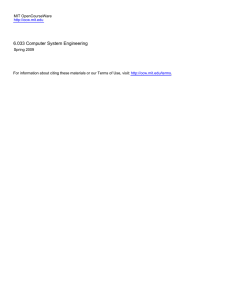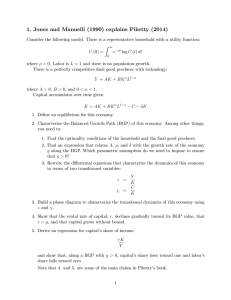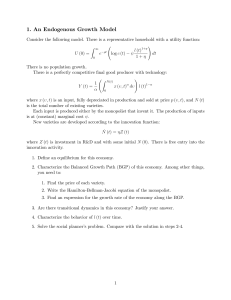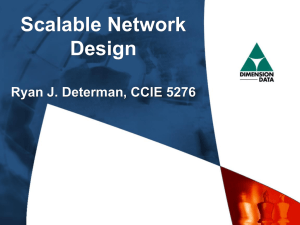Internet Routing (COS 598A) Jennifer Rexford Today: Router Configuration Tuesdays/Thursdays 11:00am-12:20pm
advertisement
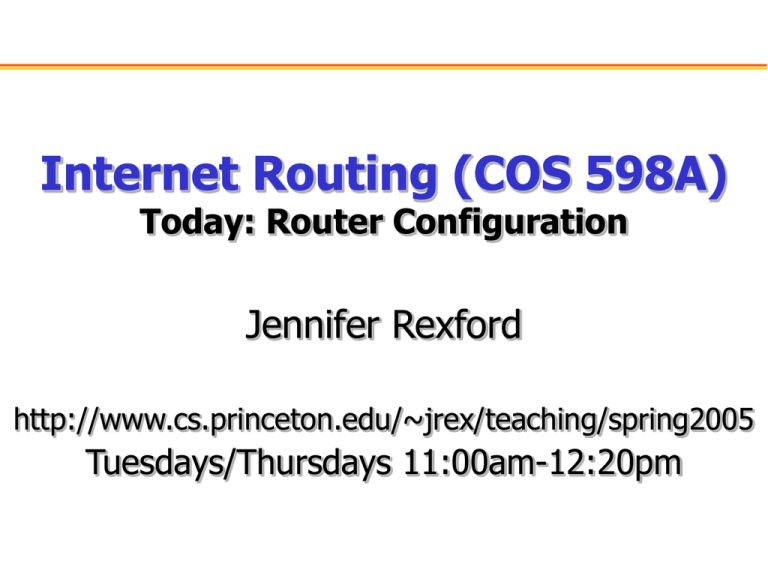
Internet Routing (COS 598A) Today: Router Configuration Jennifer Rexford http://www.cs.princeton.edu/~jrex/teaching/spring2005 Tuesdays/Thursdays 11:00am-12:20pm Outline • Individual router – Router CPU and interfaces – Links, adjacencies, and sessions – Filtering and injecting routes • Network routing design – Case study of an ISP backbone – BGP community to convey state • Current state of the art – Problems with today’s languages – Static analysis to detect mistakes – Template-based automation Configuring the Router CPU • Loopback interface – IP address for accessing the CPU • Access control for router CPU – Command-line interface and SNMP set/get – Id and password, and levels of access permission • Default parameters – E.g., TCP parameters • Services – E.g., logging, telnet, TFTP, etc. Access Interfaces: The Basics • High-level information – Media (e.g., Serial, Packet-Over-Sonet, and ATM) – Location (e.g., slot 10, port adaptor 1, port 0) – Description (i.e., a comment field) – Capacity (i.e., bandwidth) • Diverse communication media at layer 2 – Serial link, ATM, packet over SONET, etc. – Various low-level, media-specific parameters • Addressing and routing – IP address and network mask – Static route to map destination prefix to interface Access Interfaces: Layer-3 Resource Allocation • Access control – Filtering of IP packets • Based on packet-header bits (e.g., IP addresses, typeof-service bits, port numbers, and protocol) • Buffer management – Maximum queue size – Parameters for Random Early Detection (RED) • Link scheduling – Mapping of packets to queues • Based on packet-header bits – Allocation of bandwidth resources • E.g., weights for class-based queuing Example of Statically-Routed Customer hostname big-fat-router interface Loopback0 ip address 12.123.5.240 255.255.255.255 ! interface Serial10/1/0/12:0 description Static Customer Static route for 12.34.158.0/23 ip address 12.7.35.1 255.255.255.252 ip access-group 666 in ! ip route 12.34.158.0 255.255.254.0 Serial10/1/0/12:0 access-list 666 permit 12.34.158.0 0.0.1.255 access-list 666 permit 12.7.35.0 0.0.0.3 Implicit “deny” at the end… Allow incoming packets with source in 12.34.158.0/23 or 12.7.35.0/30 Link Between Two (or More) Routers • A link is just a (very small) network – Single subnet (e.g., 12.7.35.0/30) • IP addresses for each interface – One on each router • Special IP addresses – Broadcast address – Network address 12.7.35.0/30 12.123.5.240 12.7.108.3 12.7.35.1 12.7.35.2 Intradomain Routing Protocol • Interface participation – Enable interface participate in OSPF – Assign an OSPF weight (and area) • Link participation – All interfaces enabled in OSPF, in same area – Triggers them to establish an adjacency • Network of OSPF-speakers – Routers flood the link-state advertisements – Each router constructs view of the OSPF topology BGP Session With a Neighbor • BGP session – AS number of the neighbor – TCP connection between two IP addresses • Reaching the remote end of the connection – Local router must be able to reach the neighbor router – Need to be able to route to establish the session! • Diversity of configurations – One link vs. multiple links – Direct connection vs. intermediate components LR NR single access link LR NR multiple access links LR NR firewall, NAT, etc. Session With Directly-Connected Interface • BGP session with the other end of the link – Single link directly to the neighbor’s router – Local router knows how to reach the address AS 7018 interface Serial10/1/0/12:0 LR ip address 12.7.35.1 255.255.255.252 ! router bgp 7018 12.7.35.1 BGP session neighbor 12.7.35.2 remote-as 18585 neighbor 12.7.35.2 <bgp command>… ! 12.7.35.2 NR AS 18585 Static Routes to Remote BGP Speaker • BGP session associated with static routes – Multiple access links to the neighbor’s router – Or, intermediate components on the path interface POS7/0 ip address 12.7.35.1 255.255.255.252 LR ! interface POS8/0 ip address 12.7.45.1 255.255.255.252 ! POS7/0 BGP session POS8/0 router bgp 7018 neighbor 12.7.108.3 remote-as 18585 neighbor 12.7.108.3 <bgp command>… ! ip route 12.7.108.3 255.255.255.255 POS7/0 ip route 12.7.108.3 255.255.255.255 POS8/0 NR 12.7.108.3 Filtering BGP Route Advertisements • E.g., filter routes not belonging to neighbor router bgp 7018 neighbor 12.7.108.3 remote-as 18585 neighbor 12.7.108.3 distribute-list CUSTOMER in ! ip prefix-list CUSTOMER seq 5 12.34.158.0/23 ip prefix-list CUSTOMER seq 15 135.207.0.0/16 • E.g., filter routes for martian IP addresses router bgp 7018 neighbor 137.39.3.128 remote-as 701 neighbor 137.39.3.128 prefix-list MARTIAN in ! ip prefix-list MARTIAN seq 5 0.0.0.0/0 ip prefix-list MARTIAN seq 15 10.0.0.0/8 le 32 … Introducing Routes Into BGP • Introducing routes into BGP – Explicit announcement (“network”) – Redistribution from other protocols interface Serial10/1/0/12:0 description Static-routed customer ip address 12.7.35.1 255.255.255.252 ip access-group 666 in ! router bgp 7018 network 12.34.0.0 mask 255.255.0.0 redistribute static ! ip route 12.34.158.0 255.255.254.0 Serial10/1/0/12:0 Network Routing Design Network Routing Design: ISP Backbone • Inside the network – OSPF • Compute paths between routers – Internal BGP • Distribute BGP routes inside • Periphery of the network – Packet filters • Block incoming packets at entry points – Static routes • Learn how to reach non-BGP customers – External BGP • Exchange reachability information with BGP neighbors Inside the Network: Interior Gateway Protocol • OSPF: all internal links participate – Area structure driven by Point-of-Presence • Backbone area (area 0): inter-PoP links • Non-backbone areas: intra-PoP links – Weights driven by topological properties • Physical distance • Link bandwidth 20 10 15 10 PoP Inside the Network: Internal BGP • iBGP: all routers participate – Route-reflector hierarchy driven by PoP • Route reflectors: two RRs per Point-of-Presence • RR clients: connect to both RRs in their PoP – Full mesh of top-level route reflectors PoP Periphery of the Network: Packet Filters • Permit valid customer to send (prevent spoofing) – Permit source addresses belonging to customer • Permit routing protocols and management to work – Permit source address of remote BGP speaker – Permit customer to “ping” your end of the link • Prevent bogus IP addresses – Deny source addresses of “martians” – Deny source address of your own services • Prevent access to your own equipment – Deny packets destined to routers from unexpected source • Prevent unwanted applications/services – Deny SNMP port number or multicast addresses – Deny BGP port number from unexpected source Periphery of Network: External BGP • External BGP sessions – Session to each BGP-speaking neighbor – Import and export policy for each session • Policy mechanisms – Filtering: discard route announcements – Preference: assign high/low preference – Tagging: mark routes with extra state • Policy goals – Business relationships – Traffic engineering – Route aggregation Business Relationships: Assigning Preference • Prefer-customer policy – Session with peer • Import policy: assign local-pref of 80 – Session with customer • Import policy: assign local-pref of 90 route-map INPEER permit 100 set local-preference 80 ! route-map INCUST permit 100 set local-preference 90 ! Business Relationships: Tagging for Memory • Tag to remember the type of route – Session with peer: community 0:1000 – Session with customer: community 0:2000 route-map INPEER permit 100 set local-preference 80 set community 0:1000 ! route-map INCUST permit 100 set local-preference 90 set community 0:2000 ! Business Relationships: Filtering Based on Tag • Export policy based on tag – Export all routes to customers – Export only customer-learned routes to peers route-map INPEER permit 100 set local-preference 80 set community 0:1000 ! route-map OUTPEER permit 100 match community 0:2000 ! route-map INCUST permit 100 set local-preference 90 set community 0:2000 ! route-map OUTCUST permit 100 match community 0:1000 0:2000 ! Filter routes from peers Periphery of Network: Static Routes • Static route for destination prefix – Reaching destinations of a non-BGP customer – Reaching the remote end of eBGP session • Tagging to limit export of static routes in BGP – Local to the router: no injection in BGP • Prefix contained in block allocated to provider’s router • … and customer connects to Internet in only one place – Just inside the AS: inject with “no export” • Prefix contained in provider’s address space • … and customer connects to only one provider – Both in and out of AS: inject with no restriction • Prefix not contained in provider’s address space • … or customer connects to multiple providers Complexity of BGP Policies • Remembering from one router to another – Business relationship for export policy – Scope of prefix for route-aggregation – Geographic location • Side information unknown to routers – Business relationship with neighbor AS? – Customer’s prefix falls in provider’s supernet? – Customer has multiple access links or providers? • Intrinsic complexity and diversity of policies – Business relationships, traffic engineering, route aggregation, security, etc. Current State of the Art Manual Configuration • Dangerous – Typo in a routing policy: black hole – Interfaces in different OSPF areas: no traffic on link – Missing a packet filter: denial-of-service vulnerability • Expensive – Delays in deploying equipment – Hiring and training skilled engineers – Lock-in to the router vendor • Disruptive – Half of network outages (Yankee Group) – Failures of Internet services (USITS’03) – BGP routing anomalies (SIGCOMM’02, NSDI’05) The Problem With Configuration Languages • Heterogeneity – No standard language for the industry – Differences across products and versions by a vendor – Change over time due to new protocols and features • Low-level language – – – – Thousands of different commands Complex inter-relationships between commands Very little abstraction or nesting Sometimes no public grammar or parser • Poor commit semantics – Command-line interface, one command at a time – Often no support for atomic actions Problem With Configuration Languages • Router-level configuration – Configuration of individual routers, not the network – E.g., configure each end of a link separately • Complexity of distributed protocols – Some things are hard to do in distributed fashion – E.g., ensuring complete visibility of routes in iBGP – E.g., the need for BGP communities to pass state • Lack of abstractions – Research emphasis on speed and features – … not on simplicity, managability, and clean abstractions – Config languages are no better (though often worse!) than our abstractions for mechanisms, protocols, and practices Reducing Configuration Errors • Configuration checking tools – Dump the running configuration of all routers – Parse, join, and query the data – Generate reports of problems • Automated configuration – Templates and rules for generating configuration – Database for storing the values of variables – Software to fill templates and apply commands • Better configuration languages – Vendor neutral languages for routing policy (RPSL) – Research on network-wide configuration Configuration Checking Configuration Checking: Types of Checks • Errors: clear mistakes – Variables used but not defined – Mismatch between two ends of link or session • Warnings: risky behavior – Variables defined but not used – Dependence on default configuration values – Violations of best common practices • Inconsistencies: pattern mismatches – Same variable defined differently on two routers – Variables with different names defined same way • Local policy violations: – Mismatch with the operator’s explicit intent Configuration Mistakes: BGP Prefix Filtering • Martian prefixes – Goal: block announcements for bogus prefixes – Variable: prefix-list define martian prefixes – Instantiation: eBGP sessions apply the prefix-list • Configuration mistakes – Error: MARTIAN instantiated but not defined – Warning: MARTIAN defined but not instantiated – Inconsistency: MARTIAN defined differently on different routers – Local policy violation: MARTIAN not defined as 0.0.0.0/0, 10.0.0.0/8-32, 127.0.0.0/8-32, etc. Configuration Mistakes: iBGP Configuration • Internal BGP sessions – Goal: disseminate reachability info inside the AS – Mechanism: iBGP sessions between routers • Configuration mistakes – Error: Router A has iBGP session to Router B, but B does not have an iBGP session to A – Warning: iBGP session between non-Loopback addresses – Inconsistency: all routers have two route reflectors (RRs), except one – Local policy violations: all client routers should have two RRs; route RRs should form a full mesh Automated Configuration Automated Configuration System Technical Questions (TQ) What is your AS number? What export policy do you want? Do you want a dynamic default? What are your address blocks? Do you need to receive communities? DB interface <name> description <cust name> ip address <addr> <mask> ip access-group <acl> in ! router bgp 7018 neighbor <ip> remote-as <asn> neighbor <ip> route-map CUST-FACE in neighbor <ip> route-map <outmap> out neighbor <ip> distribute-list <racl> in neighbor <ip> soft-reconfiguration-inbound [neighbor <ip> send-community] ! query R U L E S interface Serial10/1/0/12:0 description CBB Customer ip address 12.7.35.1 255.255.255.252 ip access-group 666 in ! router bgp 7018 neighbor 12.7.35.2 remote-as 18585 neighbor 12.7.35.2 route-map CUST-FACE in neighbor 12.7.35.2 route-map FULL-ROUTES out neighbor 12.7.35.2 distribute-list 13 in neighbor 12.7.35.2 soft-reconfiguration-inbound ! configlet template • Automation through template and database • … but doesn’t raise the level of abstraction • So building these kind of systems is challenging router Automation Stages • Initializing a new router – Base configuration to load on the router – E.g., access control for the router CPU – E.g., enabling of services (e.g., telnet, logging) – E.g., defining MARTIAN lists and routing policies • Changing the configuration – Use cases for different activities – … with TQ, database variables, and template – E.g., “add link,” “add BGP-speaking customer,” or “move static-route customer to BGP customer) – Generates a configlet applied to the router Conclusion • Router configuration is hard – Low-level configuration languages – Wide variety of protocols and mechanisms • Improving on manual configuration – Configuration-checking tools – Automated configuration systems – Research needed on languages and abstractions • Possibility of auto-configuration? – Specify high-level network design – Ship a router and plug it in to the network – Router auto-configured from a server Next Time: Removing Routing from Routers • Three short papers – “Routing as a Service” – “The Case for Separating Routing From Routers” – “Network-Wide Decision Making: Toward a Wafer-Thin Control Plane” • Review just of the first paper – – – – Summary Why accept Why reject Directions for future work • Plan for a discussion-driven class on Thursday • Reminder: no class next week!!!
